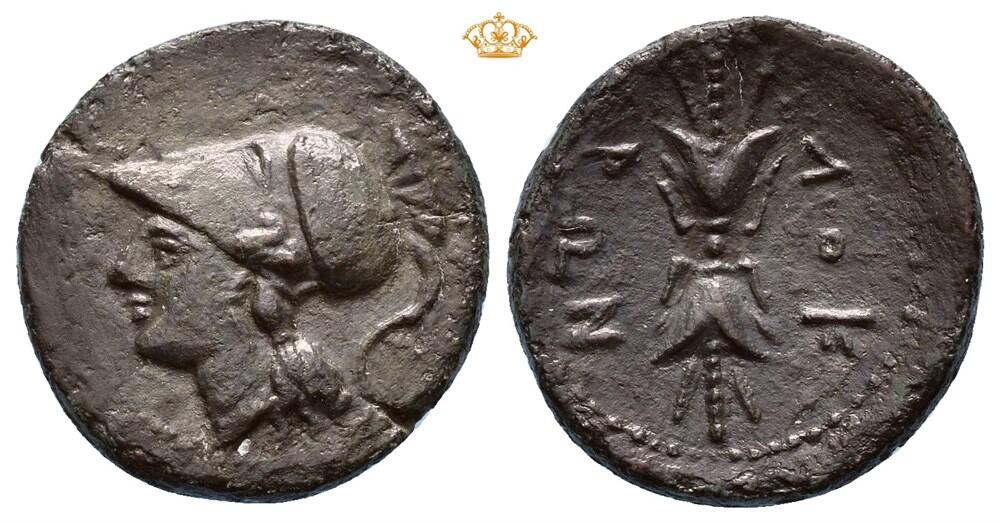Locri Epizephyrii (Agathocles), bronze, half units (5g) (Athena/winged thunderbolt) (317-279 BCE)
From SILVER
317 BCE - 279 BCE Bronze
Description
| ObverseInscription or printing placed on the obverse.: | Head of Athena left, wearing crested Corinthian helmet |
| ReverseInscription or printing placed on the reverse.: | ΛΟΚ/ΡΩΝ (Greek).Winged thunderbolt |
Mint and issuing power
| MintIdentifies the place of manufacture or issue of a numismatic object.: | Locri Epizephyrii | Ancient regionAncient region.: | Bruttium | Modern countryModern country: Italy | AuthorityIdentifies the issuing power. The authority can be "pretended" when the name or the portrait of X is on the coin but he/she was not the issuing power. It can also be "uncertain" when there is no mention of X on the coin but he/she was the issuing power according to the historical sources: | Agathocles of Syracuse (tyrant of Syracuse in 317-289 BC and self-styled king of Sicily in 304-289 BC) |
Chronology
| FromIdentifies the initial date in a range assigned in a numismatic context. | 317 BCE | toIdentifies the final date in a range assigned in a numismatic context.. | 279 BCE | PeriodTime period of the numismatic object.: Hellenistic 323-30 BC |
Physical description
| MetalThe physical material (usually metal) from which an object is made.: | Bronze |
Median weightMedian of the weights of numismatic objects (in grams). in grams | 5.00 | DenominationTerm indicating the value of a numismatic object. Examples: tetradrachm, chalkous, denarius.: | StandardStandard.: |
Image

Locri_Agathocles_Athena_thunderbolt.jpg [1]
References
| Die study referencePublication of the study: | Spinelli 20191Spinelli 2019, Group VI, Series 14, p. 128-134 | ||
| Coin series referenceReference to coin series study: | HN Italy2HN Italy, n° 2362-2370, HGC 13HGC 1, n° 1586 | ||
| Coin series web referenceCoin series web references: | |||
Obverse dies distribution
| FrequencyFrequency of specimen in distribution. ᵖ | Number of obversesNumber of obverse dies. ᵖ (o) | % (o) | Number of coinsNumber of coins. (n) | % (n) | Die nameName(s) of the die(s). |
| 1 | 48 | 87.27 | 48 | 71.64 | 3, 4, 5, 6, 7, 8, 9, 10, 11, 12, 13, 14, 15, 16, 17, 19, 21, 23, 24, 25, 26, 27, 28, 29, 30, 31, 32, 33, 34, 35, 36, 37, 38, 39, 40, 41, 43, 44, 45, 46, 47, 48, 49, 51, 52, 53, 54, 55 |
| 2 | 4 | 7.27 | 8 | 11.94 | 2, 18, 22, 50 |
| 3 | 2 | 3.64 | 6 | 8.96 | 20, 42 |
| 5 | 1 | 1.82 | 5 | 7.46 | 1 |
| Total | 55 of 55 | 100 | 67 of 67 | 100 |
Reverse dies distribution
no distribution is available
Quantification
| Number of obversesNumber of obverse dies. ᵖ (o) | 55 | Number of singletons (o1)The number of singleton coins. ᵖ | 48 |
| Number of reverse diesNumber of reverse dies. (r) | 57 | Number of coinsNumber of coins. (n) | 67 |
| Coins per obverse dieNumber of coins per obverse die. (n/o) | 1.22 | Coins per reverse dieNumber of coins per reverse die. (n/r) | 1.18 |
| Reverse per obverse ratioRatio of obverse dies divided by reverse dies. (r/o) | 1.04 | Percentage of singletons (o1)number of coins (n) divided by the number of singletons (o1) ᵖ | 87.27 % |
| Original number of dies (O) (Carter 1983 formula)The estimation of the number of coins according to Carter 1983 ᵖ | 237.7 | Coins struck if 20,000 as average productivity per dieCoins made if the average productivity for obverses (according to Carter) is 20,000. ᵖ | 4,754,000 |
| Original number of dies (O) (Esty 2011 formula)The estimation of the number of coins according to the singleton formula in Esty 2011 ᵖ (O) | 307.08 | Survival rate if 20,000 as average productivity per dieSurvival rate if average productivity is 20,000. ᵖ | 0.00001 |
| Coverage (o = % of O) (Esty 1984 formula)Esty 1984 - coverage (% of O) ᵖ (o = % of O) | 28.36% | Die productivity if survival rate 1/2,000Average productivity if survival rate is 1/2,000. ᵖ | 563.74 |
| Weight of silver (in kg) if 20,000 coins per die (O = Carter formula)Carter 1983 * Median weight * 20000 (*10 if gold or electrum) ᵖ | n.a. | Die productivity if survival rate 1/5,000Average productivity if survival rate is 1/5,000. ᵖ | 1,409.34 |
Remarks
Most likely one single workstation No die-link but very low n/o ratio
References
- ^ Spinelli, Marianna (2019), La monetazione di Locri Epizefiri tra Magna Grecia, Sicilia e regni ellenistici, Pelorias 27, Messina, 220 p.
- ^ Rutter N. Keith et alii (eds.) (2001), Historia Numorum Italy, London, xvi, 223 p., 43 pl.
- ^ Hoover, Oliver D. (2018), The Handbook of Greek Coinage Series, Volume 1. Handbook of Coins of Italy and Magna Graecia, Sixth to First Centuries BC., Lancaster-London, 2018, lxi, 527 pages, 23 cm